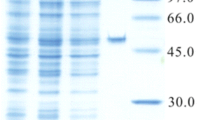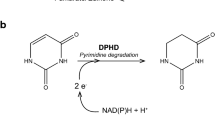Abstract
Tryptophan was found to be degraded in Saccharomyces cerevisiae mainly to tryptophol. Upon chromatography on DEAE-cellulose two aminotransferases were identified: Aromatic aminotransferase I was constitutively synthesized and was active in vitro with tryptophan, phenylalanine or tyrosine as amino donors and pyruvate, phenylpyruvate or 2-oxoglutarate as amino acceptors. The enzyme was six times less active with and had a twenty times lower affinity for tryptophan (K m=6 mM) than phenylalanine or tyrosine. It was postulated thus that aromatic aminotransferase I is involved in vivo in the last step of tyrosine and phenylalanine biosynthesis. Aromatic aminotransferase II was inducible with tryptophan but also with the other two aromatic amino acids either alone or in combinations. With tryptophan as amino donor the enzyme was most active with phenylpyruvate and not active with 2-oxoglutarate as amino acceptor; its affinity for tryptophan was similar as for the other aromatic amino acids (K m=0.2–0.4 mM). Aromatic aminotransferase II was postulated to be involved in vivo mainly in the degradation of tryptophan, but may play also a role in the degradation of the other aromatic amino acids.
A mutant strain defective in the aromatic aminotransferase II (aat2) was isolated and its influence on tryptophan accumulation and pool was studied. In combination with mutations trp2 fbr, aro7 and cdr1-1, mutation aat2 led to a threefold increase of the tryptophan pool as compared to a strain with an intact aromatic aminotransferase II.
Similar content being viewed by others
References
Dawson RMC, Elliott DC, Elliott WH, Jones KM (1970) Data for biochemical research. University Press, Oxford
Diamondstone TI (1966) Assay of tyrosine transaminase activity by conversion of p-hydroxyphenylpyruvate to p-hydroxybenzaldehyde. Anal Biochem 16:395–401
Ehrlich F (1912) Über Tryptophol (β-Indolyläthylalkohol), ein neues Gärprodukt der Hefe aus Aminosäure. Ber Dtsch Chem Ges 45:883
Fantes P, Roberts LM, Hütter R (1976) Free tryptophan pool and tryptophan biosynthetic enzymes in Saccharomyces cerevisiae. Arch Microbiol 107:207–214
Gaitonde MK, Evans G, Hartmann MK (1979) Determination of tryptophan by manually operated and autoanalyzer methods based on the formation of norharman. Anal Biochem 92:338–344
Granner DK, Tomkins GM (1970) Tyrosine aminotransferase (rat liver). Methods Enzymol 17A:633–637
Hagemann F (1969) Vergleichende Untersuchungen zur Umsetzung von d- und l-Tryptophan sowie von N-Acetyl-Tryptophan an ausgewählten Hefearten. Inaugural Dissertation, Justus Liebig-Universität, Giessen
Hardie ID, Dawes IW (1977) Optimal conditions for selecting specific auxotrophs of Saccharomyces cerevisiae using temperature-sensitive suicide mutants. Mut Res 42:215–222
Heilmann HD, Lingens F (1968) Zur Regulation der Nicotinsäurebiosynthese in Saccharomyces cerevisiae. Hoppe-Seylers Z Physiol Chem 349:231–236
Herbert D, Phipps PJ, Strange RE (1971) Chemical analysis of microbial cells. In: Norris JR, Ribbons DW (eds) Methods in microbiology. Academic Press, New York London, 5B:242–265
Kradolfer P (1981) Tryptophanstoffwechsel in Saccharomyces cerevisiae. Thesis Eidg. Techn. Hochschule Zürich No. 6769
Lingens F, Goebel W, Uesseler H (1967) Regulation der Biosynthese der aromatischen Aminosäuren in Saccharomyces cerevisiae. 2. Repression, Induktion und Aktivierung. Eur J Biochem 1:363–374
Lowry OH, Rosebrough NJ, Farr AL, Randall RJ (1951) Protein measurements with the Folin phenol reagent. J Biol Chem 193:265–275
Miozzari G, Niederberger P, Hütter R (1978a) Tryptophan biosynthesis in Saccharomyces cerevisiae: Control of the flux through the pathway. J Bacteriol 134:48–59
Miozzari G, Niederberger P, Hütter R (1978b) Permeabilisation of microorganisms by Triton X-100. Anal Biochem 90:220–233
Niederberger P, Miozzari G, Hütter R (1981) The biological role of the “general control” of amino acid biosynthesis in Saccharomyces cerevisiae. Mol Cell Biol 1:584–593
Reed G, Peppler HJ (1973) Yeast technology. AVI Publ. Co., Westport, Connecticut
Schindler F, Zähner H (1971) Stoffwechselprodukte von Mikroorganismen. Tryptanthrin, ein von Tryptophan abzuleitendes Antibioticum aus Candida lipolytica. Arch Microbiol 79:187–203
Schürch AR, Miozzari J, Hütter R (1974) Regulation of tryptophan biosynthesis in Saccharomyces cerevisiae: Mode of action of 5-methyl-tryptophan and 5-methyl-tryptophan sensitive mutants. J Bacteriol 117:1131–1140
Shetty AS, Gaertner FH (1973) Distinct kynureninase and hydroxykynureninase activities in microorganisms: occurrence and properties of a single physiological discrete enzyme in yeast. J Bacteriol 113:1127–1133
Walton EF, Carter BLA, Pringle JR (1979) An enrichment method for temperature-sensitive and auxotrophic mutants of yeast. Mol Gen Genet 171:111–114
Author information
Authors and Affiliations
Rights and permissions
About this article
Cite this article
Kradolfer, P., Niederberger, P. & Hütter, R. Tryptophan degradation in Saccharomyces cerevisiae: Characterization of two aromatic aminotransferases. Arch. Microbiol. 133, 242–248 (1982). https://doi.org/10.1007/BF00415010
Received:
Accepted:
Issue Date:
DOI: https://doi.org/10.1007/BF00415010




